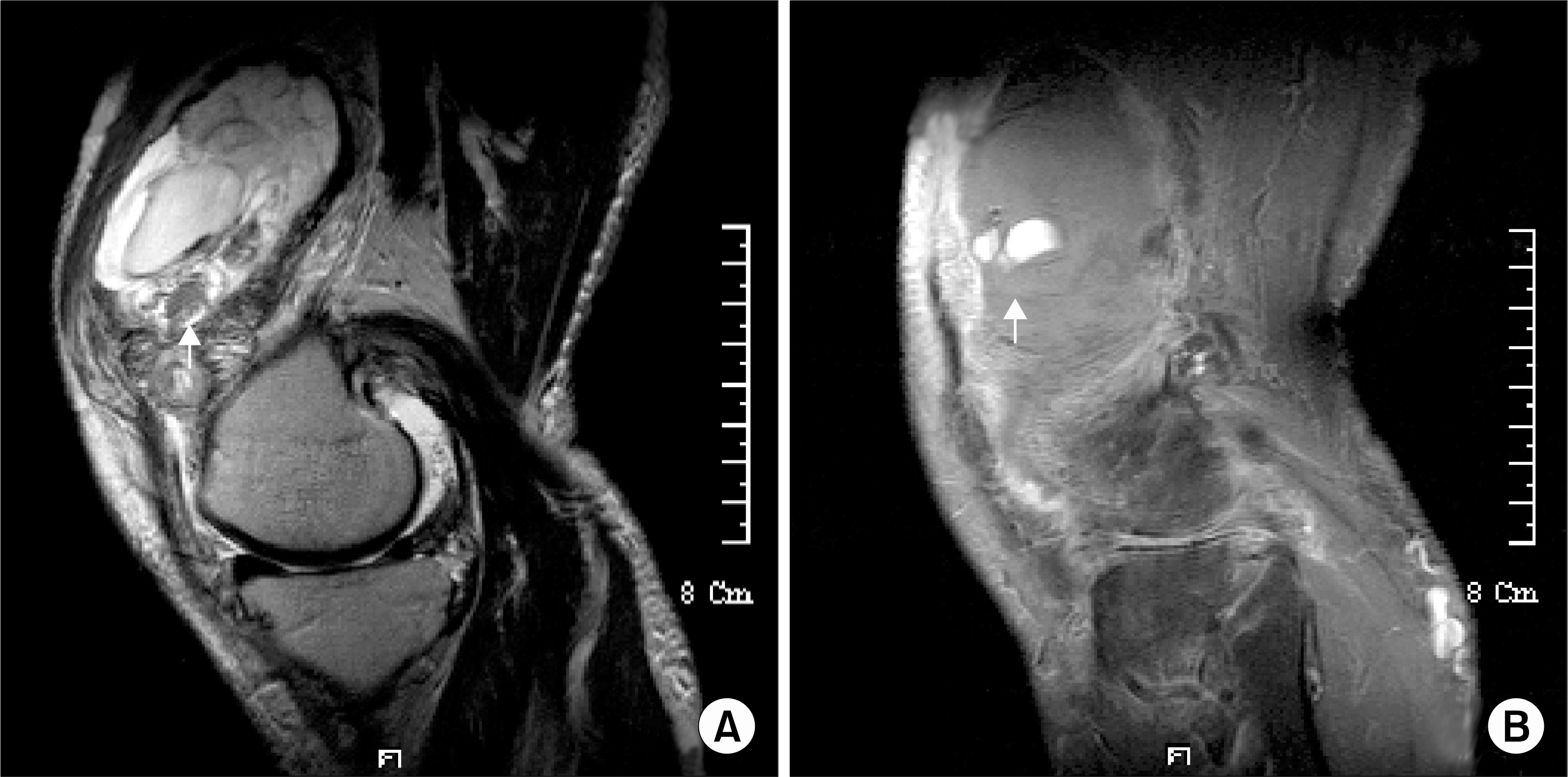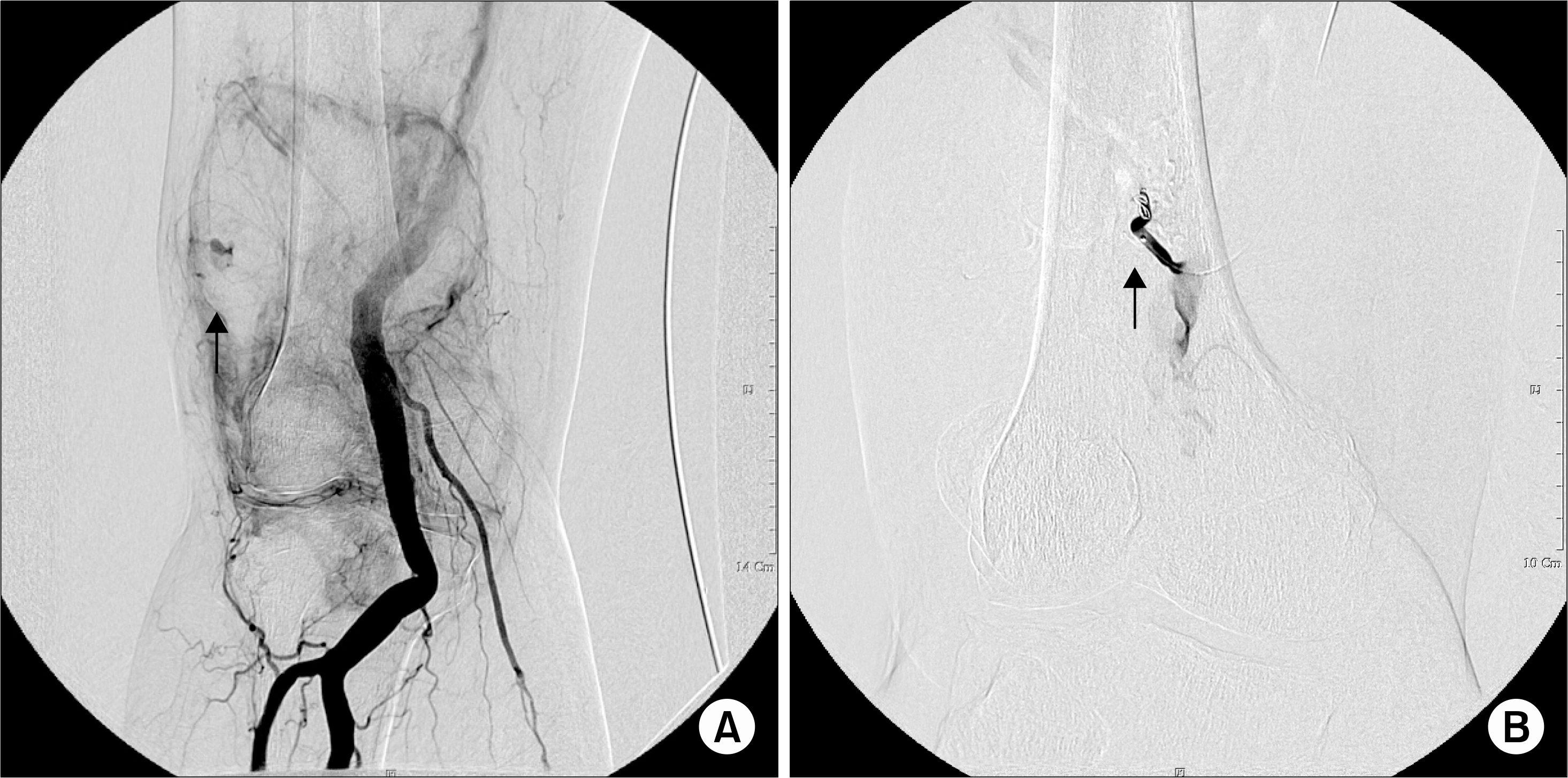Abstract
Hemarthrosis can occur in patients with a predisposition to hemorrhage such as hemophilia or anticoagulant therapy. A 72-year-old man presented with an acute painful swelling in the right knee. He was on anticoagulant therapy after a mechanical aortic valve replacement due to aortic valve insufficiency. There was no history of trauma and international normalized ratio (INR) was maintained at 3.76. On arthrocentesis of the knee, bloody synovial fluid was obtained. With the diagnosis of hemarthrosis, INR was maintained at 2. With immobilization, the knee pain gradually improved. Three weeks after discharge, right knee painful swelling was exacerbated, and arthrocentesis again revealed bloody synovial fluid. After magnetic resonance imaging (MRI) was performed, pseudoaneurysm of the right lateral superior genicular artery was diagnosed. The angiographic embolization was performed after which, he showed marked improvement. Knee MRI should be considered in hemarthrosis with atypical clinical progress, because it can detect lesions amenable to therapeutic intervention as in this case.
REFERENCES
1). Jansen NW., Roosendaal G., Bijlsma JW., Degroot J., Lafeber FP. Exposure of human cartilage tissue to low concentrations of blood for a short period of time leads to prolonged cartilage damage: an in vitro study. Arthritis Rheum. 2007. 56:199–207.

2). Hume RL., Short LA., Gudas CJ. Hemarthrosis: a review of the literature. J Am Podiatry Assoc. 1980. 70:283–6.

3). Landefeld CS., Beyth RJ. Anticoagulant-related bleeding: clinical epidemiology, prediction and prevention. Am J Med. 1993. 95:315–28.

4). Landefeld CS., Goldsman L. Major bleeding in outpatients treated with warfarin: incidence and prediction by factors known at the start of outpatient therapy. Am J Med. 1989. 87:144–52.

5). Tsutsumi K., Saito H., Ohkura M. Traumatic pseudoaneurysm of the subclavian artery following anterior dislocation of the shoulder: a report of a surgical case. Ann Thorac Cardiovasc Surg. 2006. 12:74–6.
6). Pritsch T., Parnes N., Menachem A. A bleeding pseudoaneurysm of the lateral genicular artery after total knee arthroplasty: a case report. Acta Orthop. 2005. 76:138–40.
7). Guy RJ., Spalding TJ., Jarvis LJ. Pseudoaneurysm after arthroscopy of the knee. A case report. Clin Orthop Relat Res. 1993. 295:214–7.
8). Blyth T., Hunter J., Madhok R., Vallance R. Subsynovial vascular abnormality causing recurrent hemarthrosis in an 84-year-old man. J Rheumatol. 1995. 22:552–3.
9). Klein GE., Raith J., Passler J., Szolar DH., Sorantin E., Hausegger KA. Spontaneous recurrent hemarthrosis of the knee joint: endovascular treatment of a ruptured aneurysm with platinum microcoils. A case report. J Bone Joint Surg Am. 1997. 79:594–6.
10). Ris HB., Klaiber C. Hemarthrosis of the ankle secondary to false aneurysm caused by impingement from an osteophyte. A case report. J Bone Joint Surg Am. 1989. 71:935–7.

11). Rich NM., Hobson RW., Collins GJ Jr. Traumatic arteriovenous fistulas and false aneurysms: a review of 558 lesions. Surgery. 1975. 78:817–28.
12). Thumboo J., O'Duffy JD. A prospective study of the safety of joint and soft tissue aspirations and injections in patients taking warfarin sodium. Arthritis Rheum. 1998. 41:736–9.

13). Palareti G., Leali N., Coccheri S., Poggi M., Manotti C., D'Angelo A, et al. Bleeding complications of oral anticoagulant treatment: an inception-cohort, prospective collaborative study (ISCOAT). Italian study on complications of oral anticoagulant therapy. Lancet. 1996. 348:423–8.
14). Noorpuri BS., Maxwell-Armstrong CA., Lamerton AJ. Pseudoaneurysm of a geniculate collateral artery complicating total knee replacement. Eur J Vasc Endovasc Surg. 1999. 18:534–5.

15). Stanley D., Cumberland DC., Elson RA. Embolization for aneurysm after knee replacement: brief report. J Bone Joint Surg Br. 1989. 71:138.
16). ᄋmary R., Stulberg SD., Vogelzang RL. Therapeutic embolization of false aneurysms of the superior medial geniculate artery after operations on the knee. J Bone Joint Surg Am. 1991. 73:125–7.




 PDF
PDF ePub
ePub Citation
Citation Print
Print




 XML Download
XML Download